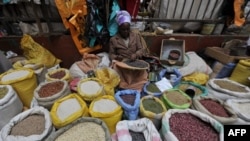A coalition of proponents will present its roadmap for increased production and consumption of beans and similar foods like lentils and peas at the Africa Food Systems Forum, to be held in Dar es Salaam, Tanzania.
“Beans is How,” the name for a coalition of more than 60 non-profit organizations, companies and research institutes, has set its eyes on Kenya, pushing for a 100% increase in the consumption of beans and other foods classified as pulses.
Jean Claude Rubyogo, head of the Pan-African Bean Research Alliance (PABRA), an organization that pushes for beans as a source of food and income for the continent, said the first step is to help farmers grow more beans.
"First of all, we need to double the production because if we don't have enough, like in Kenya, there are many people, maybe half, who would like to eat beans daily and even as a meal but the availability is minimum,” he said. “So, we need to increase productivity, we need to see how we can reduce the cost to the consumer and at the same time incentivize the farmer with better varieties, with better agronomic practices so that they can increase production and productivity."
Climate change has affected bean farming just as it has impacted other crops. Unpredictable weather patterns have made it challenging for farmers to cultivate beans and get good harvests.
Experts say low awareness among farmers about utilizing the proper seed varieties for their specific local conditions has led to reduced yields. The presence of pests and diseases has also played a role in declining bean production.
Rubyogo said a reduction of planting and harvesting time can help alleviate the farmers' hunger and poverty.
"For now, we have varieties going up to 65 days, 70 days, 80 days,” he said. “That's shorter than any other food crop, so you can see when it's short, it allows farmers to get cash because it reduces cash hunger periods. It also reduces the hunger period in families so that people can get food in a short period of 70 days. That means you can grow several seasons a year if you invest in water management."
Experts are also working on beans that can take less cooking time, saving families energy and time.
Despite not producing enough beans, according to the Global Diet Quality Project, half of Kenyans eat pulses daily.
Paul Newnham, head of the Sustainable Development Goal 2 Advocacy Hub, which coordinates the Beans is How campaign, said beans are universal and nutritious on top of it.
"Beans is something you find in all different cultures around the world,” he said. “So, you find traditions that have used beans right back from indigenous cultures and all types of different cuisines. Beans are also relatively cheap compared to many other foods … Beans are also super nutritious. They have not only protein, they have fiber, and they have lots of micro-macronutrients. They are also great for the soil."
Newnham said Beans is How has developed a roadmap to increase the production and consumption of beans.
"The first is to influence and activate a community of bean stakeholders and a champion and influencers in this, being producers, retailers, champions, chefs, young people, and social media influencers, to make beans visible and accessible and desirable and at the same time to build understanding among the decision makers as the value of beans and tackling the policy agenda to ensure and inspire the public to eat, grow more beans, he said."
Beans is How will be featured at the Africa Food Systems Forum in Tanzania next week. Bean advocates will host a market stall there, demonstrating ways to cook the food.








